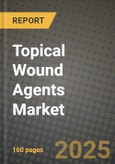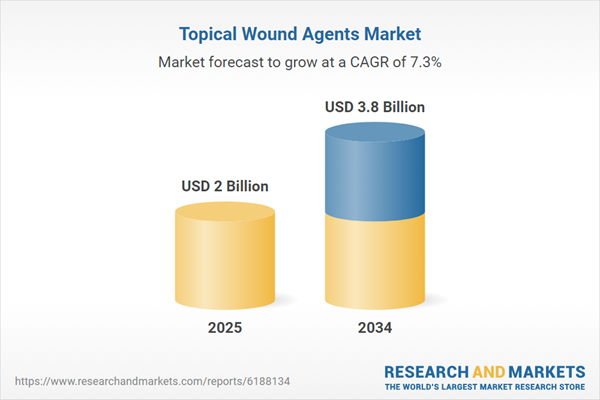The Topical Wound Agents Market is a crucial segment within the broader wound care landscape, comprising creams, gels, ointments, sprays, and foams that are applied directly to wounds to prevent infection, promote healing, and manage exudate. These agents are widely used across acute and chronic wound management, including diabetic ulcers, pressure sores, surgical incisions, burns, and traumatic injuries. The market has been expanding due to the rising global prevalence of chronic diseases, aging populations, and increased rates of surgical interventions. Innovations in formulations, including antimicrobial, enzymatic, and bioactive compounds, are enhancing therapeutic outcomes and patient compliance. The demand for non-invasive, easy-to-use wound care products is also propelling interest in advanced topical agents that offer quicker healing and improved cosmetic results.
The topical wound agents market experienced strong growth fueled by the rising incidence of chronic wounds and a growing focus on infection prevention. Silver-based and iodine-based antimicrobials continued to dominate, but newer alternatives like honey-based and PHMB (polyhexamethylene biguanide) formulations gained significant market traction. Many companies expanded their product lines to include combination therapies that integrate anti-inflammatory, antimicrobial, and regenerative properties. Telehealth and remote patient monitoring platforms increasingly incorporated wound assessment tools, influencing demand for home-usable, over-the-counter topical agents. In hospital settings, evidence-based use of bioactive wound agents, including growth factors and collagen-based treatments, became more prevalent. Additionally, increased public and institutional focus on antimicrobial resistance (AMR) encouraged the development of non-antibiotic topical alternatives for infection management.
The market for topical wound agents is expected to witness further innovation, particularly in biologically derived compounds and peptide-based healing agents. Manufacturers are likely to focus on multifunctional products that reduce inflammation, combat biofilm, and accelerate epithelialization simultaneously. Growth is anticipated in outpatient and home care settings, driven by the aging population and increasing patient preference for decentralized care models. Nanotechnology-based delivery systems may emerge as a game-changer, offering targeted delivery and enhanced absorption with minimal side effects. Moreover, as sustainability becomes a core industry goal, demand for biodegradable formulations and environmentally conscious packaging is expected to rise. However, pricing pressure from generics and the need for clinical validation of novel agents remain key hurdles for market entry and adoption.
Key Insights: Topical Wound Agents Market
- Increasing adoption of bioactive wound agents, including peptides and growth factors, is reshaping the clinical landscape of chronic wound management.
- Emergence of natural and non-antibiotic topical solutions, such as honey-based and herbal agents, is gaining traction amidst rising AMR concerns.
- Telemedicine and home-based wound care are driving demand for OTC and easy-to-apply topical formulations with proven efficacy.
- Integration of nanotechnology in topical wound agents is improving drug delivery, bioavailability, and antibacterial performance.
- There is a growing trend toward eco-friendly, biodegradable packaging and plant-based formulations in response to sustainability goals.
- Rising incidence of chronic wounds such as diabetic ulcers and pressure sores is significantly boosting demand for advanced topical treatments.
- Aging global populations are contributing to a higher prevalence of wound-related complications, especially in long-term care settings.
- Increased healthcare spending and access to wound care solutions in emerging markets are expanding the global footprint of topical wound agents.
- Ongoing innovation in wound healing compounds and their regulatory approvals are enhancing market availability and clinician adoption.
- One major challenge in the topical wound agents market is the limited clinical evidence for newer agents, which affects payer reimbursement decisions and delays hospital adoption despite their promising therapeutic potential.
Topical Wound Agents Market Segmentation
By Drug Type
- Antiseptics
- Antibiotics
- Nonsteroidal Anti-Inflammatory Agents (NSAIDS)
- Other Drugs
By Dosage Forms
- Creams
- Lotions
- Powders
- Emulsions
- Gels
- Other Dosage Forms
By Application
- Chronic Wounds
- Acute Wounds
By End-Use
- Hospitals
- Clinics
- Other End-Users
Key Companies Analysed
- 3M Health Care
- Smith+Nephew plc
- Mölnlycke Health Care AB
- ConvaTec Group plc
- Coloplast A/S
- Medline Industries
- Integra LifeSciences (Derma Sciences)
- B. Braun Melsungen AG
- KCI (3M)
- Hollister Incorporated
Topical Wound Agents Market Analytics
The report employs rigorous tools, including Porter’s Five Forces, value chain mapping, and scenario-based modeling, to assess supply-demand dynamics. Cross-sector influences from parent, derived, and substitute markets are evaluated to identify risks and opportunities. Trade and pricing analytics provide an up-to-date view of international flows, including leading exporters, importers, and regional price trends.Macroeconomic indicators, policy frameworks such as carbon pricing and energy security strategies, and evolving consumer behavior are considered in forecasting scenarios. Recent deal flows, partnerships, and technology innovations are incorporated to assess their impact on future market performance.
Topical Wound Agents Market Competitive Intelligence
The competitive landscape is mapped through proprietary frameworks, profiling leading companies with details on business models, product portfolios, financial performance, and strategic initiatives. Key developments such as mergers & acquisitions, technology collaborations, investment inflows, and regional expansions are analyzed for their competitive impact. The report also identifies emerging players and innovative startups contributing to market disruption.Regional insights highlight the most promising investment destinations, regulatory landscapes, and evolving partnerships across energy and industrial corridors.
Countries Covered
- North America - Topical Wound Agents market data and outlook to 2034
- United States
- Canada
- Mexico
- Europe - Topical Wound Agents market data and outlook to 2034
- Germany
- United Kingdom
- France
- Italy
- Spain
- BeNeLux
- Russia
- Sweden
- Asia-Pacific - Topical Wound Agents market data and outlook to 2034
- China
- Japan
- India
- South Korea
- Australia
- Indonesia
- Malaysia
- Vietnam
- Middle East and Africa - Topical Wound Agents market data and outlook to 2034
- Saudi Arabia
- South Africa
- Iran
- UAE
- Egypt
- South and Central America - Topical Wound Agents market data and outlook to 2034
- Brazil
- Argentina
- Chile
- Peru
Research Methodology
This study combines primary inputs from industry experts across the Topical Wound Agents value chain with secondary data from associations, government publications, trade databases, and company disclosures. Proprietary modeling techniques, including data triangulation, statistical correlation, and scenario planning, are applied to deliver reliable market sizing and forecasting.Key Questions Addressed
- What is the current and forecast market size of the Topical Wound Agents industry at global, regional, and country levels?
- Which types, applications, and technologies present the highest growth potential?
- How are supply chains adapting to geopolitical and economic shocks?
- What role do policy frameworks, trade flows, and sustainability targets play in shaping demand?
- Who are the leading players, and how are their strategies evolving in the face of global uncertainty?
- Which regional “hotspots” and customer segments will outpace the market, and what go-to-market and partnership models best support entry and expansion?
- Where are the most investable opportunities - across technology roadmaps, sustainability-linked innovation, and M&A - and what is the best segment to invest over the next 3-5 years?
Your Key Takeaways from the Topical Wound Agents Market Report
- Global Topical Wound Agents market size and growth projections (CAGR), 2024-2034
- Impact of Russia-Ukraine, Israel-Palestine, and Hamas conflicts on Topical Wound Agents trade, costs, and supply chains
- Topical Wound Agents market size, share, and outlook across 5 regions and 27 countries, 2023-2034
- Topical Wound Agents market size, CAGR, and market share of key products, applications, and end-user verticals, 2023-2034
- Short- and long-term Topical Wound Agents market trends, drivers, restraints, and opportunities
- Porter’s Five Forces analysis, technological developments, and Topical Wound Agents supply chain analysis
- Topical Wound Agents trade analysis, Topical Wound Agents market price analysis, and Topical Wound Agents supply/demand dynamics
- Profiles of 5 leading companies - overview, key strategies, financials, and products
- Latest Topical Wound Agents market news and developments
Additional Support
With the purchase of this report, you will receive:- An updated PDF report and an MS Excel data workbook containing all market tables and figures for easy analysis.
- 7-day post-sale analyst support for clarifications and in-scope supplementary data, ensuring the deliverable aligns precisely with your requirements.
- Complimentary report update to incorporate the latest available data and the impact of recent market developments.
This product will be delivered within 1-3 business days.
Table of Contents
Companies Mentioned
- 3M Health Care
- Smith+Nephew PLC
- Mölnlycke Health Care AB
- ConvaTec Group PLC
- Coloplast A/S
- Medline Industries
- Integra LifeSciences (Derma Sciences)
- B. Braun Melsungen AG
- KCI (3M)
- Hollister Incorporated
Table Information
| Report Attribute | Details |
|---|---|
| No. of Pages | 160 |
| Published | October 2025 |
| Forecast Period | 2025 - 2034 |
| Estimated Market Value ( USD | $ 2 Billion |
| Forecasted Market Value ( USD | $ 3.8 Billion |
| Compound Annual Growth Rate | 7.3% |
| Regions Covered | Global |
| No. of Companies Mentioned | 10 |









